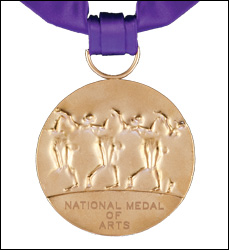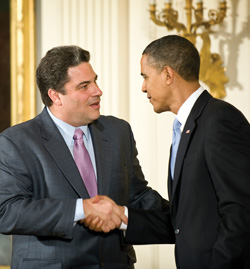Thank you, Mister President
Conservatory Dean David Stull Accepts the 2009 National Medal of Arts from President Obama

(photo by Tanya Rosen-Jones ’97)
You are standing next to the president of the United States. He is about to shake your hand and present you with the highest honor given by your government to artists and arts patrons.
What is going through your mind?
“Don’t screw up,” says Dean of the Conservatory David H. Stull, laughing and not missing a beat.
Stull’s mood, however, quickly turns philosophical: “I was thinking that it is an honor to be the one to accept this award. It is the culmination of more than a century of work and reflects the contributions of thousands who have dedicated their lives to the advancement of music, art, and education—not only in this country, but around the globe.”
And what did the president say, sotto voce, during this brief encounter, which was punctuated by applause from such luminaries as conductors Michael Tilson Thomas and John Williams, actress Rita Moreno, soprano Jessye Norman, and painter Frank Stella?
“He leaned in to me and said, ‘You know, I’m really pleased to select Oberlin for this award. Please tell everyone on the team at Oberlin that they are doing a terrific job, and congratulations.’”
This watershed moment in Oberlin’s history took place during a White House East Room ceremony on February 25, 2010. The award is not often given to institutions; Oberlin was the only professional music school honored by President Obama this year.
This was actually Stull’s second invitation to the White House; one year ago to the day, on February 25, 2009, he was present when Stevie Wonder was awarded the Library of Congress Gershwin Prize. [Ed note: Wonder performed at the Kohl Building dedication concert and received an Honorary Doctor of Music Degree. Coverage will appear in the 2010-11 issue of Oberlin Conservatory.]
Stull says he was impressed, on both occasions, by President Obama’s passion for music. “It is real, and it is informed. He is able to speak extemporaneously about music with incredible knowledge and insight.”
The president’s familiarity with Oberlin also struck Stull as impressive: “When we were in the Blue Room taking photos and chatting following the ceremony, he was very present and in the moment. It was quite clear to me that he certainly knows about Oberlin, and that he is greatly interested in our mission. There is no question that he supports not only the role of art, but also the role of higher education within the context of the United States.”
Oberlin’s citation, read during the ceremony, commends the conservatory “for preparing young musicians to become great cultural contributors. As a model of music education, America’s oldest continuously operating conservatory proves that exceptional training enriches artists, our communities, and our nation.”

(photo by Richard Frasier)
The National Medal of Arts was first conferred in 1985 and is a rare and singular honor granted to artists and arts patrons in recognition of the wealth and depth of their creative expressions. According to the National Endowment for the Arts (NEA), whose charge it is to make recommendations to the president of medal-worthy individuals and organizations, several compelling factors contributed to the selection of the conservatory: foremost among them, the successfulness with which the conservatory prepares artistically talented and intellectually gifted students for professional careers in music and a lifetime of effective advocacy for the arts.
“These individuals and organizations show us how many ways art works every day. They represent the breadth and depth of American architecture, design, film, music, performance, theatre, and visual art,” says NEA Chairman Rocco Landesman. “This lifetime honor recognizes their exceptional contributions, and I join the president and the country in saluting them.”
In addition to Tilson Thomas, Williams, Moreno, Norman, and Stella, others honored at the White House ceremony were graphic designer Milton Glaser; architect and sculptor Maya Lin; arts patron and design advocate Joseph P. Riley Jr.; the School of American Ballet; and, absent from the ceremony, singer and songwriter Bob Dylan and director and actor Clint Eastwood.
Oberlin College President Marvin Krislov, who was appointed by President Obama to the National Council on the Humanities in 2009, attended the ceremony with Robert Lemle ’75, chair of Oberlin’s Board of Trustees; trustee Stewart Kohl ’77; and Associate Dean Andrea Kalyn.
“Being awarded the National Medal of Arts is a tremendous honor for the Oberlin Conservatory of Music,” says Krislov. “It is a great tribute to the conservatory’s faculty, staff, and students, past and present, whose relentless dedication to achieving excellence is the hallmark of music at Oberlin.”
